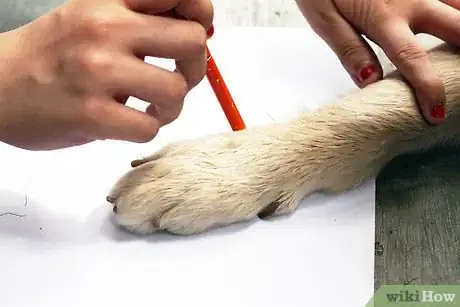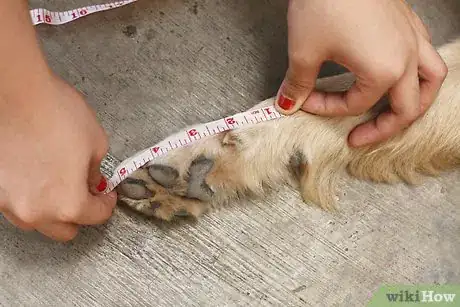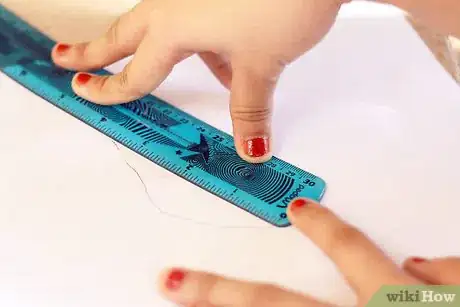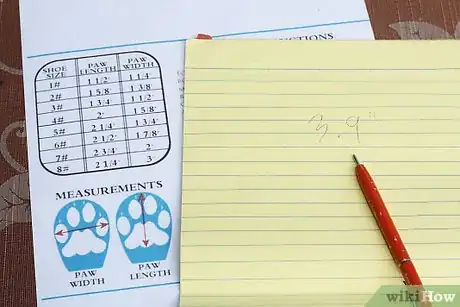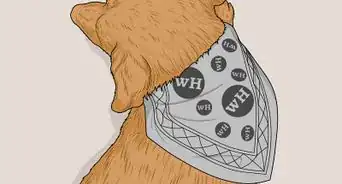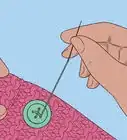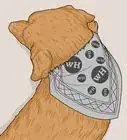This article was co-authored by Pippa Elliott, MRCVS. Dr. Elliott, BVMS, MRCVS is a veterinarian with over 30 years of experience in veterinary surgery and companion animal practice. She graduated from the University of Glasgow in 1987 with a degree in veterinary medicine and surgery. She has worked at the same animal clinic in her hometown for over 20 years.
wikiHow marks an article as reader-approved once it receives enough positive feedback. In this case, 93% of readers who voted found the article helpful, earning it our reader-approved status.
This article has been viewed 45,116 times.
Your dog shouldn't be treated as a fashion accessory, but there are instances where dog shoes or boots can be beneficial for your dog. If he has a problem with his paw which needs protecting, or if you live in extreme climates, your vet may suggest you try some protective boots. If you are putting boots on your dog, remember that it is unnatural and a strange experience for the dog. To size him for shoes, you need to determine the width of the widest part of his paw. You may also need to determine the length.
Steps
Measuring Your Dog's Paws
-
1Mark the length and width of his paw on a piece of paper. One relatively simple way to measure your dog for shoes is to place his paw on a piece of paper and mark the size. Place a sheet of paper on a hard surface that your dog can stand on. You can encourage your dog to step onto the paper by feeding him a treat. Only the paw you are measuring needs to be on the paper.
- When a dog puts pressure on a paw, the paw will splay so ensure that he is putting weight on the paw you are measuring. If you measure a paw that is not splayed, the shoes will be too small.
- You can do this by gently holding the opposite paw in your hand so all the dog's weight is on the paw you are measuring.
- Clearly mark each side at widest point, and front and back. Don't forget to include the toenails.[1]
-
2Make a paw impression. An alternative technique for marking your dog's paw size is to wet his paw in water, and then press it down on a piece of paper. The wetness will make a paw print on the paper which will indicate the size of his paw. As with the pencil marking technique, you need to ensure that his paw is fully splayed and that you take into account his toenails.[2]
- Measure the length and width of the impression left by his paw print, and use this as the basis for sizing him. Always measure at the widest point of the paw.
- Different paws may be different sizes. Be sure to measure each paw individually if you are getting boots for more than one paw.
Advertisement -
3Use a tape measure. You can also use a tape measure to determine the length and width of your dogs paws directly. Hold his paw in your hand, ensuring that it is fully splayed, and then measure across it. You could try and get your dog to stand on the tape measure if this is easier. Measure the widest part of his paw.[3]
- A ruler can also work if you don't have a tape measure. You can use a ruler to measure his paw, or get him to stand on it.
- Don't forget to do separate measurements for length and width.
Determining Your Dog's Shoe Size
-
1Measure the marks left on the paper. Once you have marked the outer edges of his paw on a piece of paper, you can simply measure the length and width of each paw with a ruler or tape measure. Record these measurements. If you are uncertain about anything, or they look too dissimilar, do some repeat measurements to make sure you have been accurate.
- It's worth double-checking the size. If you buy boots that don't fit, your dog will not be able to wear them and you will have to go through the whole process again.
- Incorrectly sized shoes can rotate around the foot, which creates a tripping hazard.
-
2Compare your measurements to a sizing chart. When you are happy with the measurements you have made, you should look at a dog paw sizing chart. You can compare your measurements to the size guides that different dog boot manufacturers provide for their customers.
- If you are ordering boots online, you will most likely need to fit your measurements to one of the sizes offered by the company.
- Often these will only require a measurement of the widest part of the paw.
- These sizes can range from XXXSmall at 1 1/2 inches across the widest part, all the way to XLarge at 3 1/2 inches across the widest part.[4]
-
3Use a pictorial paw size chart. Some dog shoe manufacturers have pictorial paw charts available to download and print from their websites. Be sure to print them in real size.[5] These charts have outlines of paws of different sizes which correspond to the size of dog boots they produce. You can hold your dog's paw down against the different images to find the size that is the best fit for him.
- Bear in mind that there is a limited number of sizes.
- After comparing his paw to the images on the pictorial chart, make sure that your original measurements correspond and give you the same result.
Warnings
- Dogs who show signs of balance or neurological issues should not wear shoes before consulting with a veterinary professional.⧼thumbs_response⧽
- Shoes may hinder more than help. They prevent the dog from directly feeling the ground with his feet, which can create a greater sense of imbalance and might result in slips and falls.⧼thumbs_response⧽
Things You'll Need
- Large sheet of blank paper
- Ruler
- Pen
- Dog treats or kibble
References
About This Article
To measure your dog's paws for shoes, start by placing one of its paws on a piece of paper. Make sure your dog is putting weight on the paw or else the measurement you take might be too small. Once its paw is on the paper, use a pencil to mark the length and width. If your dog won't stand still, try wetting its paw and then pressing it on the paper so it leaves a mark. Either way, measure the length and width of the markings on the paper to find out your dog's shoe size. When you're shopping for dog shoes, use those measurements to find the right size! For tips from our Veterinary co-author, like how to measure your dog's paws without using paper, keep reading!
